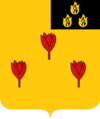Maştağa
Maştağa (also, Mashtaga, Mashtaghy, and Mashtagi) is a settlement and municipality in Baku, Azerbaijan. It has a population of 42,196.[2] According to the popular historical manuscripts, the inhabitants of the village are the descendants of an ancient nomadic Turkish tribe which defeated and brought down Cyrus the Great and settled down in Baku during the V-VI centuries[3].
Maştağa | |
|---|---|
Municipality | |
 Coat of arms | |
 Maştağa | |
| Coordinates: 40°31′58″N 50°00′14″E | |
| Country | |
| City | Baku |
| Raion | Sabunçu |
| Population (2008)[1] | |
| • Total | 42,196 |
| Time zone | UTC+4 (AZT) |
| • Summer (DST) | UTC+5 (AZT) |
History
Mashtagha Village (later transformed into a settlement) with an area of up to 6,000 hectares, which is considered to be one of the largest settlements in Baku, has an ancient history. Here are preserved ancient customs and traditions of Azerbaijan, beliefs and beliefs, mythological imaginations, oral literature. More precisely, the population of the village transmits all these generations to one another and lives today as the most beautiful spirits.
The village of Mashtaga also confirms its history with its architectural monuments, which have been erected in the history of stone. Unfortunately, the extensive archaeological excavations in the village are not satisfactory, and historical facts are not satisfactory for science. Since the Middle Ages, 27 baths, 21 houses, defense towers, 20 mosques have been built in the Middle Ages, and its historic territory is rich in large-scale public buildings, leaving it second after Baku. The presence of 5 mosques, 7 baths and 5 pogroms in one neighborhood was an exception in Absheron.
The word "Mashtaga" appeared before this village itself. The prominent Azerbaijani historian, Abbasqulu Agha Bakikhanov, suggested the idea of the Mashtaga toponym "massaget" in the "Gulustan Ilam". Another meaning of this place was also given to Abbasgulu Agha Bakikhanov as "Mashadi Agha" in "Gulistani-Iram". Baku khanate Mirza Muhammad khan once built a magnificent castle here. There was a mosque next to the tower. It was destroyed in the 20s of the last century. Copper coins were discovered during excavations around the village. Researchers say the village has an ancient history. Unfortunately, Mashtaga, which was exposed to the occupation of the invaders, has been repeatedly destroyed.
Population
According to the historical period, this village is likely to be the provincial city in the Middle Ages. Although the first information about the population of Mashtaga originates in the early 19th century, the population of this village was many times higher in the Middle Ages. The number of houses in Mashtag were 854 in 1849, 1137 in 1886 and 1260 in 1921. The population was 3619 in 1842 and was the number one among the Baku villages in the years to come, but in the years to come, the number was 6179, in 1884 it was 7784, in 1913 it was 8730, in 1926 it was 8220 and In 1939 there were 11642 people. If we did not count the villages belonging to the territory of the mining-factory region in 1913 among the Baku villages, it was still in the first place according to the population. Soviet-era construction work accelerated settlement in the village, where the fastest growing. The population was 16.9 thousand in 1959, 22.2 thousand in 1970, 31.9 thousand in 1979, 40.2 thousand in 1989, 38.9 thousand in 1999, 43.7 thousand per year and 45.1 thousand people in 2016.[4]
Notable natives
- Mammed Mammadyarov — revolutionary, People's Commissar of Social Security of the Azerbaijan SSR (1922–1927).[5]
- Yashar Nuri — People's Artist of Azerbaijan, Laureate of the State Prize of the Republic of Azerbaijan.
- Alibaba Mammadov — People's Artist of Azerbaijan, singer, professor.
- Salam Kadirzadeh — Azerbaijani writer, journalist, writer.
- Boyukaga Gasimzadeh — poet, translator, member of Azerbaijan Writers' Union since 1939.
References
- World Gazetteer: Azerbaijan Archived June 22, 2011, at the Wayback Machine – World-Gazetteer.com
- []
- Bakıxanov, Abbasqulu Ağa (1951). Gülüstan-i İrəm. Bakı: Elmlər Akademiyası nəşriyyatı.
- State Statistical Committee of the Republic of Azerbaijan
- "Мамедьяров Мамед". Great Soviet Encyclopedia.
.svg.png)